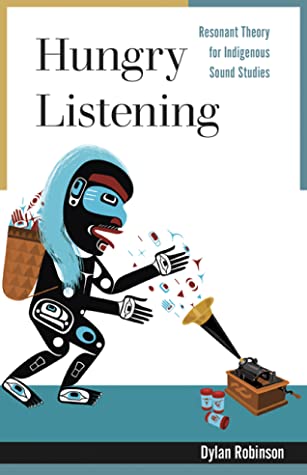
Sound studies. Indigenous sound studies, to be precise, by Stó:lō scholar Dylan Robinson. The centre of the work is consideration, through very close and careful attention to a range of works and performances, of the various ways in which settler art music and Indigenous music get put in relation and taken up. That might seem like a very specific project, and certainly some of its more narrowly musicological concerns were a bit beyond me, but it anchors a fascinating and useful weave of broader ideas. I can already anticipate a few elements of the book sticking with me. The title, for instance, points towards an understanding of settler orientations to the world derived from Stó:lō thought, which captures a certain relentless, extractivist consumption at the heart of settler ways of being, including consumption of the Other through particular modes listening. I very much appreciated the lesson that the Indigenous/settler divide when it comes to music goes far beyond differences in aesthetics to the basic question of what music is – its ontology – and that “Indigenous song … serves strikingly different functions, including that of law and primary historical documentation” (41). Though there are a range of ways that this happens, most of the time when Indigenous music is brought into relation with Western art music, it is done in a way that imposes the Western ontology. There is an extraction, a sometimes violent repurposing, a smoothing over of difference and dissonance for the benefit hungry settler ears – often, in the Canadian context, in a way very much in line with the multicultural strand of settler colonial nationalism. I also think the book’s idea of “critical listening positionality” is important. It doesn’t use the word “standpoint,” but it seems to be a similar (though not identical) idea – a sort of engagement with our own listening practices based on a non-essentialist and dynamic understanding of the relationships which situate us in a given moment and more broadly. Another figure in the book that feels like it might be quite useful is the “metaphor of the palimpsest” (59), taken up from another writer as a way to think about practices of “layered listening” (ibid). This would involve a sort of deep yet mobile attention to both positionality and to that which is present only as trace or even that which inaudibly underlies the main focus of listening. Also, I appreciate its exploration of form and craft as integral to the work that both music and writing do: It’s not just what you say, but the form that you use to say it, that will disrupt hungry listening, catalyze a more critical form of engagement, or do whatever else you are trying to accomplish with your work. Anyway, I could go on listing specifics, but I think overall what I most appreciate about this book is the space it opens for thinking about how settler colonialism shapes our perceptions and what it might mean to collectively, and with due attention to our positionality, work towards new, decolonial ways of listening – particularly, that it does so with no pretense of easy answers or quick resolution. |
Originally posted by Scott on Goodreads.